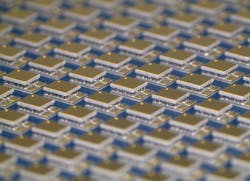Phononic chooses Fabrinet for thermoelectric cooler production
Cooling technology company Phononic has chosen Fabrinet (NYSE: FN) to supply manufacturing capabilities for Phononic’s line of thermoelectric coolers (TECs) for optical transceivers. Fabrinet will produce the TECs, which are designed to work in hermetic and non-hermetic packages (see, for example, “Phononic non-hermetic compatible thermoelectric cooler targets telecom, datacom laser packages”), in its facilities in Thailand. The production capacity, which will augment Phononic’s existing resources in Durham, NC, should be up and running by the second quarter of 2021.
Phononic says it has seen significant uptick in demand for the TECs, symbolized by the more than 150% increase in revenue growth it expects to see from its optoelectronics business this year. The growth has threatened to exceed the capabilities of the Durham facility, according to Kevin Granucci, vice president and general manager of Phononic. Between the capacity added in Durham over the past 24 months and what Fabrinet will provide, the production capabilities for the TECs will be 7X what was in place at the beginning of 2019, Granucci said.
The lines in Durham and Thailand will be mirror images, according to Granucci; the ability to replicate readily what was in place in North Carolina was one of the reasons Phononic chose Fabrinet, he said. Other points in Fabrinet’s favor were its familiarity with optical communications technology, its responsiveness in the midst of the COVID-19 pandemic, and positive feedback from Phononic’s customers about the choice.
Fabrinet also will provide Phononic with a presence in Asia. About half of the company’s product revenue in optoelectronics is from customers who design in Asia, and Phononic believes in a presence local to its customers, Granucci said. This philosophy is one reason why Phononic will maintain TEC production capabilities in Durham, he pointed out.
For now, the process of establishing the production line at Fabrinet will continue. Engagement with and bringing a new customer online requires at least eight steps, according to Dr. Harpal Gill, president and COO of Fabrinet. Among these procedures are documenting requirements, setting up the supply chain, establishing a transfer plan (which itself typically consists of about 100 different items), staff training, and acquiring and installing the necessary equipment.
“The transfer duration varies depending on the magnitude and complexity of the transfer,” wrote Gill in response to questions submitted by Lightwave. “It can be as short as 4 weeks or as long as 4 months. Last year, we did a transfer that involved the move of an entire factory from overseas, comprising 2000 SKUs, more than 1000 pieces of equipment, and over $70 million worth of inventory. The entire process transfer took 4 months.
“The success of the transfers depends largely on good planning and execution. We have developed a checklist over the last 20 years comprising 100 items that need to be checked and met to ensure all contingencies are covered. Every transfer has to be guaranteed to be 100% successful as our customers expect nothing less,” Gill concluded.
For related articles, visit the Optical Technologies Topic Center.
For more information on optical components and suppliers, visit the Lightwave Buyer’s Guide.
To stay abreast of optical communications technology, subscribe to Lightwave’s Enabling Technologies Newsletter.
About the Author

Stephen Hardy
Editorial Director and Associate Publisher, Lightwave
Stephen Hardy is editorial director and associate publisher of Lightwave and Broadband Technology Report, part of the Lighting & Technology Group at Endeavor Business Media. Stephen is responsible for establishing and executing editorial strategy across the both brands’ websites, email newsletters, events, and other information products. He has covered the fiber-optics space for more than 20 years, and communications and technology for more than 35 years. During his tenure, Lightwave has received awards from Folio: and the American Society of Business Press Editors (ASBPE) for editorial excellence. Prior to joining Lightwave in 1997, Stephen worked for Telecommunications magazine and the Journal of Electronic Defense.
Stephen has moderated panels at numerous events, including the Optica Executive Forum, ECOC, and SCTE Cable-Tec Expo. He also is program director for the Lightwave Innovation Reviews and the Diamond Technology Reviews.
He has written numerous articles in all aspects of optical communications and fiber-optic networks, including fiber to the home (FTTH), PON, optical components, DWDM, fiber cables, packet optical transport, optical transceivers, lasers, fiber optic testing, and more.
You can connect with Stephen on LinkedIn as well as Twitter.
